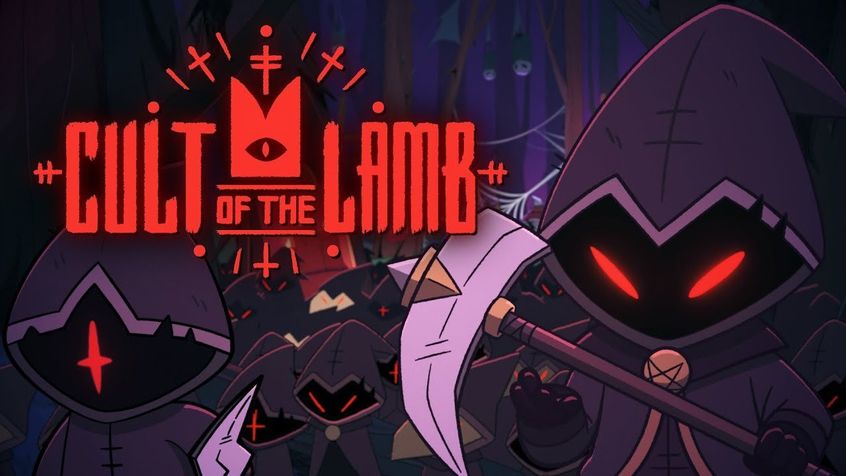Cult Of The Lamb
I’m going to put a caveat on this review. I play every game on my laptop using a touchpad. It kills my friends inside, but at this point, it’s become a bit of a meme. It means, though, that there will always be games I’m terrible at, with fact action games being at the top of the list. When I load up a game, and it strongly recommends I plug in a controller, then, I recognise my play experience is going to be a bit different from others’. With Cult of the Lamb, then, my experience is one tempered by playing on touchpad, of trying my very best with a game that warned me from the outset that the limitations I’d placed upon myself were not reasonable ones.
But I tried.
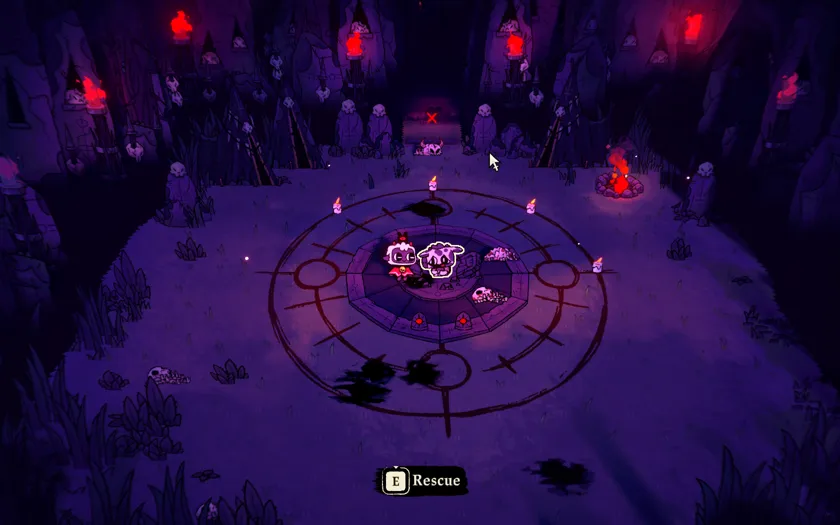 One of these is me, and it isn’t the lamb.
One of these is me, and it isn’t the lamb.
Cult of the Lamb is a combination management sim and roguelite, which sounds like an odd combination, but works fairly well. You play as a lamb, recruited by an imprisoned god to overthrow a cadre of false gods and restore the imprisoned god to their rightful place. The lamb must build and manage a cult of followers, establishing tenets of faith and collecting their devotion, while using the resources gained on crusades to feed and build the cult.
The game is, once again, a combination roguelite and management sim, with the roguelite elements providing the resources used to build and improve the colony. The roguelite elements follow the traditional beats of providing several weapons options, varying those weapons options between runs, and allowing upgrades and swaps throughout the run. Each run lasts ten to fifteen minutes, with progressively more difficult enemies as the player progresses, and different items that can be acquired along the way.
These items are then used for thee colony management side of the game. Here, the player feeds and cares for their followers, building different buildings that allow for resource harvesting, and generally maintains the colony. The player can also choose what the cult actually believes in, ranging from being free-ranging hippies to merciless cannibals who sacrifice their elderly and feast on their flesh.
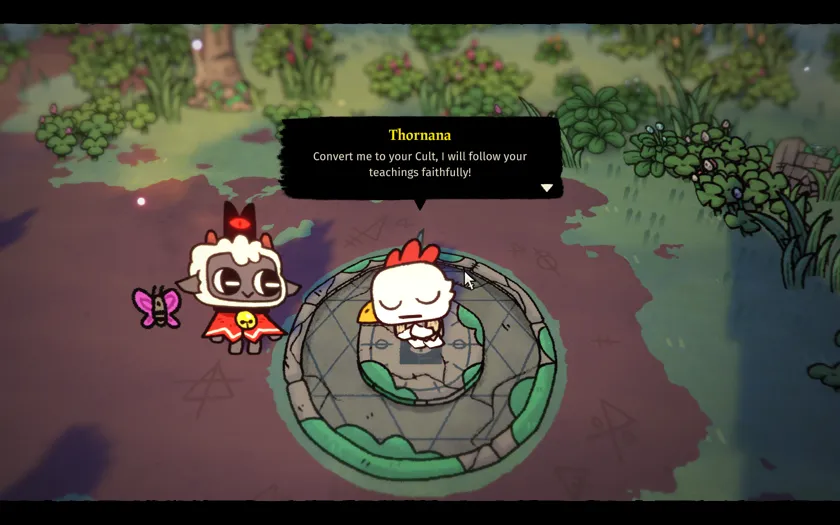 That is the world’s most deceptive butterfly.
That is the world’s most deceptive butterfly.
It’s a bit difficult to decide how I feel about the combination of elements of the game because I am, once again, playing on a touchpad, and there is no roguelite in existence that is optimised for touchpad. By linking resource harvesting to the roguelite elements, more management-minded players have no choice but to plow into fights they will almost certainly lose. In my playthrough, I got to a frustrating point where, no matter how I tried, I could not progress through the combat, and therefore, couldn’t progress my colony any further either. While the roguelite crusades make absolute sense from a narrative perspective, they can get frustrating, especially with a difficulty that seems to scale up just a bit faster than I do. Upon seeing certain weapons spawn at start (I’m looking at you, giant axe), I knew the entire dungeon run would be a wash.
My dislike of Cult of the Lamb’s dungeons isn’t solely a result of my own lack of skills. There is a shallowness to these dungeons that is the natural consequence of the player having to split their time and energy between two radically different genres. As the player moves through the dungeons, time continues to pass outside, and with it, the actions and needs of the cult continue. The dungeon runs must necessarily be brief to give the player time to complete them and still hurry back to manage their cult. This means that Cult of the Lamb never gets the chance to be a true roguelite, but remains an odd malformed dungeon crawler, more reliant on being quick on the controls than on the careful planning and building that characterises many other roguelites. I am generally bad at roguelites, yes, but I am uniquely bad at Cult of the Lamb because it doesn’t provide me the opportunity to make a build that makes the game work for me. It provides a shallow hack-and-slash as one of its fundamental progression mechanics, leading to slogging gameplay. The dungeon elements can be fun, but they require a skill I don’t have, and a patience for hack-and-slash that I will never possess.
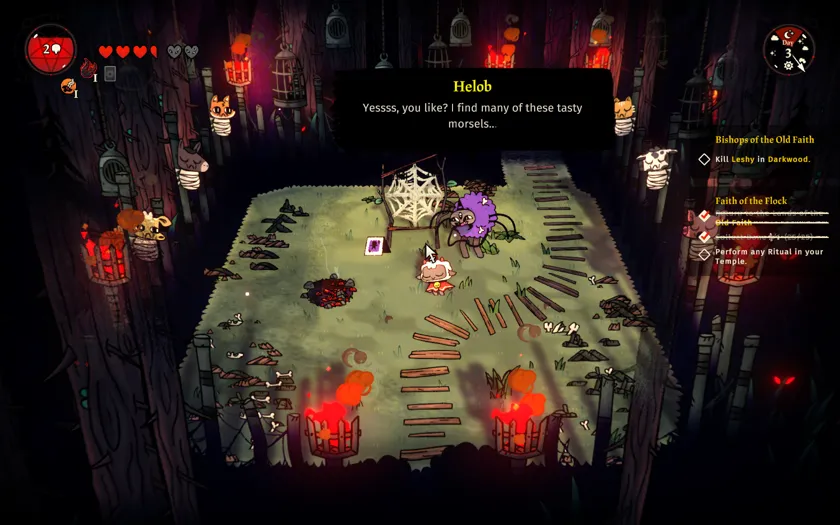 The lamb clearly likes.
The lamb clearly likes.
The flipside of this mixed-genre gameplay is the colony management elements. Much like with the roguelite elements, the colony management elements recognise that they are sharing space with the roguelite elements, and as such, are less developed than they might have been otherwise. While there is space to customise and build a cult following a specific vision, that space is limited. The colony will always face the same situations with the same choices, creating no real incentive to do anything but the ideal play.
This becomes coupled with the more tedious elements of colony management. While the cult members can be assigned to tasks, many tasks have to be unlocked over time and with the resources gathered through the dungeon crawl. Tasks like cleaning and watering crops are, at least initially, the sole purview of the player character. When coupled with the mechanics to raise followers’ loyalty, the gameplay loop becomes a cycle of talking to people, cleaning up messes, and solving every problem ad infinitum. I spent my time managing the colony thinking about the automation I could build if I had the resources from the dungeons. I spent my time in the dungeon thinking about the time I wasn’t spending managing and leveling up the colony. Rather than one element creating a break in the routine of the other, each distracts from the other, and makes of it a lesser experience.
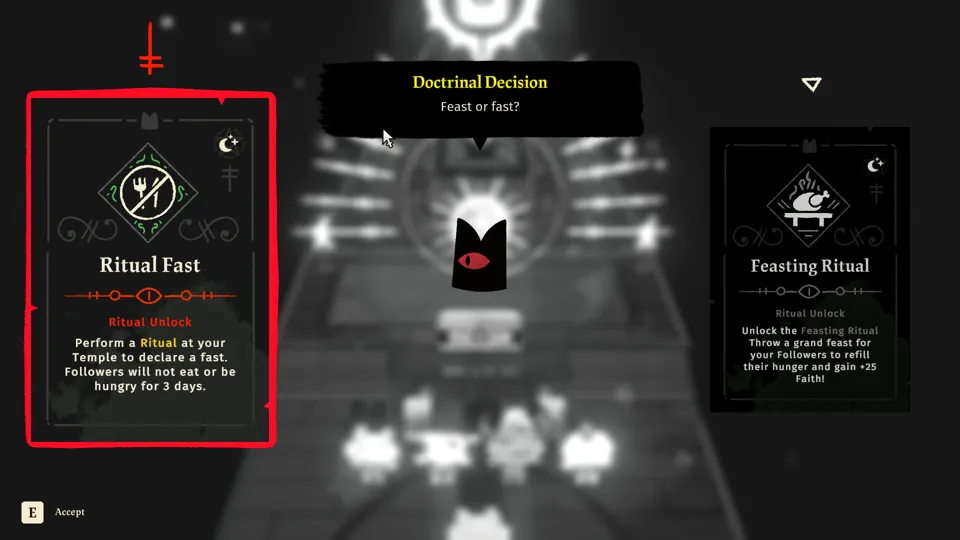 Fasts are poorly named. In my experience, they are more like slows.
Fasts are poorly named. In my experience, they are more like slows.
The final nail in Cult of the Lamb’s coffin for me, though, is its humour and how its art style embodies that humour. Cult of the Lamb has a very specific style that I think of as Oatmeal-esque. It’s a style that accentuates over-the-top cartoon violence and gore, fixates on poop as one of its core sources of humour, and draws its characters as hyper-cartoonish versions of themselves. It’s a juvenile style of humour that lacks the self-awareness of something like Crush Your Enemies , instead expecting its audience to agree with the humour at face value, and laugh because of the references to the thing both the creator and the audience find funny.
This is entirely subjective, but I hate this style of humour, and I hate this style of art. While its sense of humour may appeal to some members of its audience, I was thoroughly put-off by Cult of the Lamb’s poop jokes and art style. There are some games where the various components of the game are compelling enough for me to overlook a difference in artistic taste. With Cult of the Lamb, when both game major elements are already a bit of a chore, the humour just cements the sense that the game has nothing it can offer me.
 Okay, so the dice game is pretty good.
Okay, so the dice game is pretty good.
Cult of the Lamb is not a bad game. As much as I have torn into what I see as elements that are lacking, the reality is that I have also sunk a dozen hours into it in the hope that it would become something more than it was. I wanted the colony management elements to work. I wanted the dungeon crawler to be fun. I kept coming back to it in the hopes that the game I wanted this to be would appear. It never did, and I am disappointed by that. Instead, I’m left with a game that combines the most shallow elements of its gameplay with an off-putting art style and sense of humour. It has the potential to be interesting and more than what it is, but flubs it, instead becoming a tedious slog of poop jokes and monotonous chores.
Developer: Massive Monster
Genre: Roguelite, Simulation
Year: 2022
Country: Australia, United Kingdom
Language: English
Play Time: 15-20 Hours
Youtube: https://youtu.be/yE-ghM-bl_8
